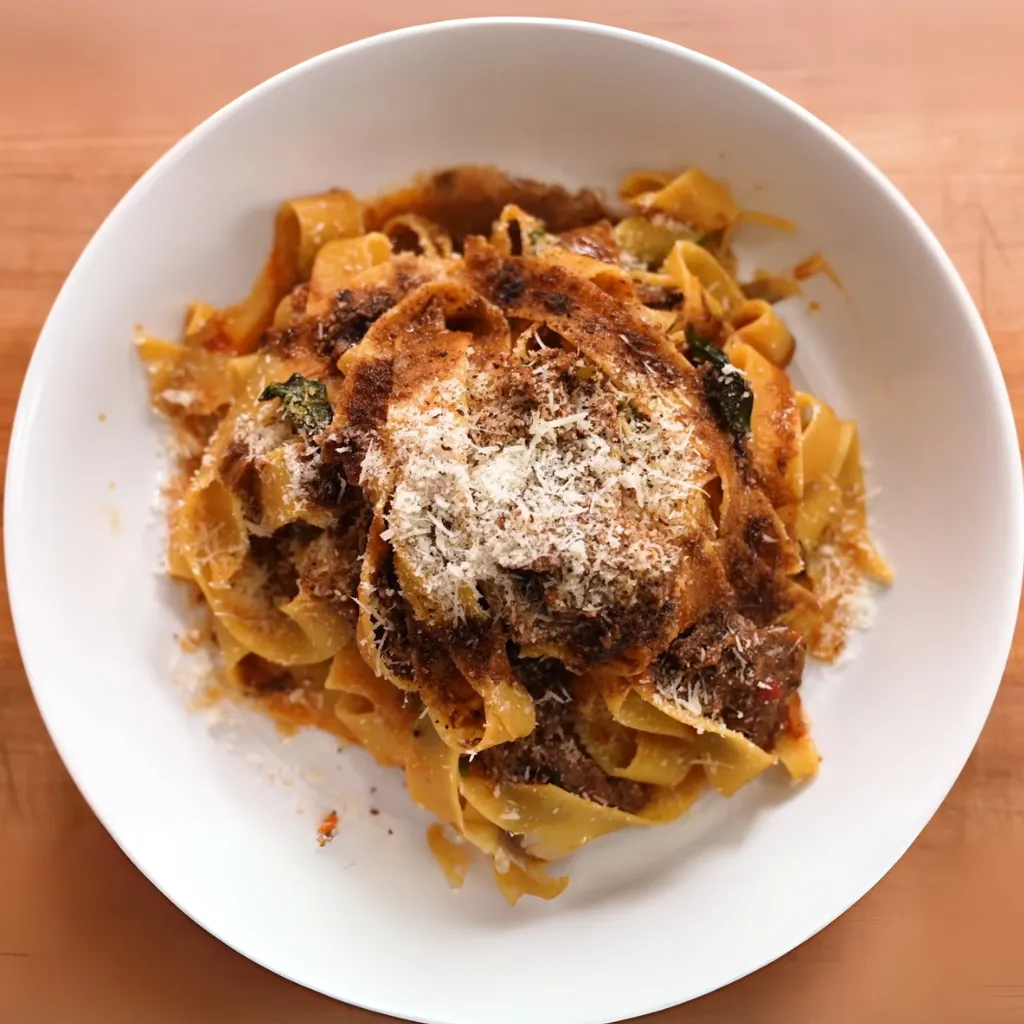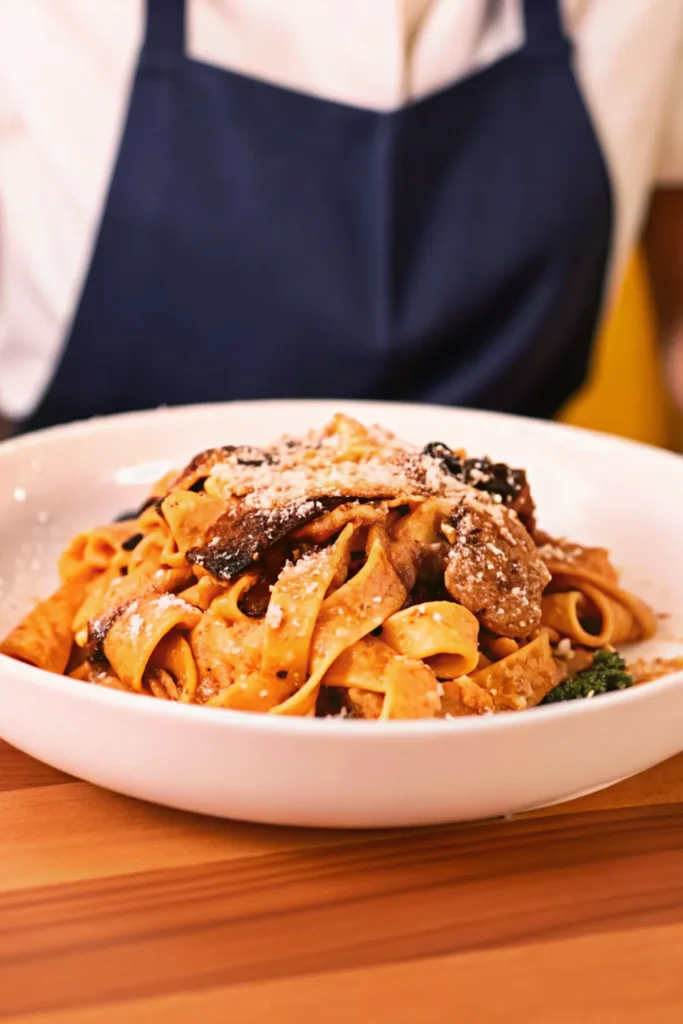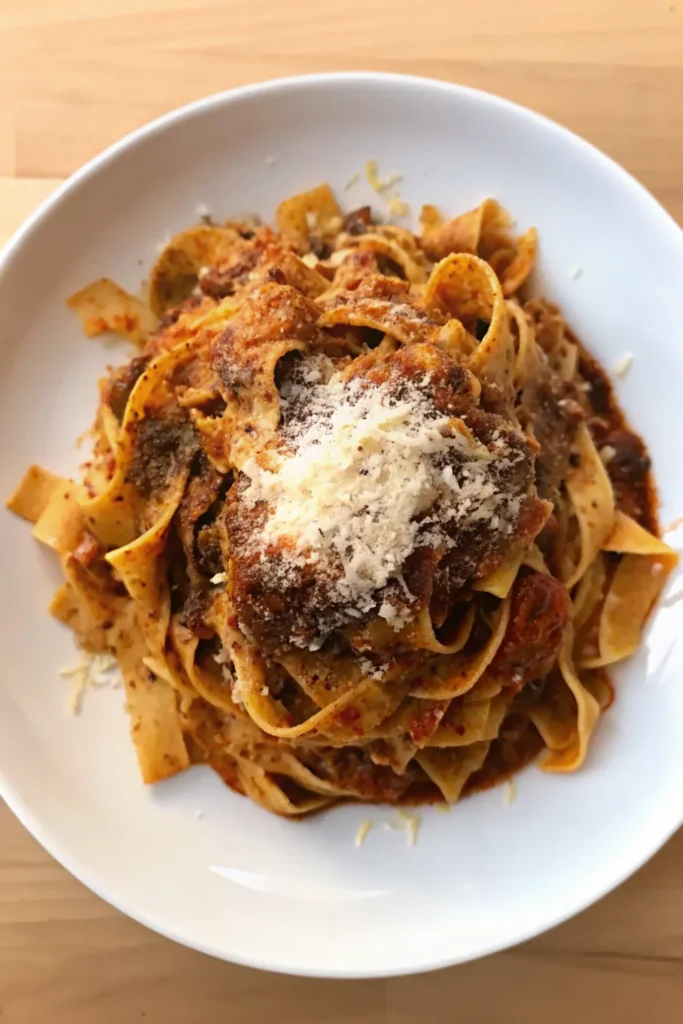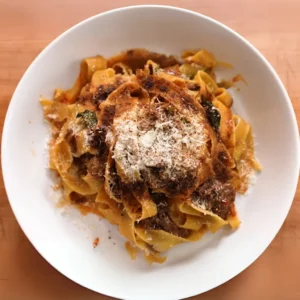Short Rib Ragu Over Pappardelle: The Coziest Pasta You’ll Ever Make
This short rib ragu over pappardelle might just be the coziest pasta I’ve ever made, and I do not say that lightly.
You know that kind of dish that hugs you back? The kind that fills your kitchen with the kind of smell that makes people linger? That’s exactly what happened the day I tested this recipe. I was standing there with my Dutch oven, watching short ribs sizzle and listening to them crackle like they had something to say. Meanwhile, my house started smelling like a five-star trattoria had set up shop in my living room. No one in my family waited until dinner. They hovered. They “sampled.” Let’s be honest, they practically begged.
Honestly, I wasn’t even mad about it.
What makes this dish so special isn’t just the rich, slow-cooked meat or the wide, silky ribbons of pappardelle. It’s how it all comes together, layer by layer. From the charred grape tomatoes to the ridiculously tender short ribs, this isn’t one of those “quick weeknight meals.” This is a project. But it’s one that pays off big time.
And you don’t need a fancy setup to pull it off. Just a little patience, a heavy pot, and a craving for something downright soulful. Ready to get cozy? Let’s make it happen.
WHY THIS RECIPE WORKS
- It’s slow-cooked to perfection – The beef short ribs and chuck roast braise for hours, breaking down into melt-in-your-mouth pieces that soak up all the rich tomato and herb flavors. You don’t need a fancy technique, just time and a good pot.
- Charred grape tomatoes make a difference – Charring those little tomatoes brings out a smoky sweetness you just can’t get from canned. It’s a small step that packs a punch and adds depth you’ll taste in every bite.
- A sauce that clings to the pasta – Thanks to a bit of pasta water and grated cheese, the sauce doesn’t just sit on top of your noodles, it wraps around them like it belongs there. That’s the difference between good pasta and “wait, who made this?” pasta.
- It feels like restaurant food at home – This dish honestly tastes like something you’d pay $26 for at a fancy place, only you made it in your kitchen, probably in sweatpants. Major win.
- Perfect for weekends or special occasions – This isn’t your Tuesday night spaghetti. This is your “friends are coming over” or “I need to impress my in-laws” kind of meal. It feeds a crowd and gets people talking.
- Totally flexible with portioning – Whether you make 1 pound or 2 pounds of pasta, the ragu is easy to scale, freeze, or repurpose. That means less stress, fewer leftovers going to waste, and more ways to enjoy it again.
INGREDIENTS
Meat and main ingredients
- 1.5 lbs (681g) bone-in beef short ribs (about 3 ribs)
- 1 lb (454g) beef chuck roast, cut into 1-inch chunks
- Kosher salt and freshly ground black pepper, to taste
- 2.5 tablespoons (38g) vegetable oil
Vegetables and aromatics
- 1 large onion, very finely minced
- 3 to 4 large carrots, peeled and very finely minced
- 4 ribs celery, finely minced
- 3 cloves garlic, very finely chopped
- 1 lb (454g) grape tomatoes
Pastes and flavor boosters
- 2 tablespoons (30g) tomato paste
- 2 tablespoons (30g) harissa paste (optional, use alcohol-free)
- 2 tablespoons (30mL) balsamic vinegar (plus more for finishing)
Liquids for braise
- 1.5 cups (355mL) pomegranate juice
- 0.5 cup (118mL) beef stock
- 1 tablespoon (15mL) balsamic vinegar
- Additional 2.5 cups (591mL) beef stock, for braising
Herbs
- 15 sprigs fresh thyme
- 2 bay leaves
Pasta and finishing
- 1 to 2 lbs (454–908g) pappardelle or fettuccine
- 1 cup (122g) Pecorino Romano cheese, grated (plus more for topping)
- 1.5 cups fresh basil leaves, roughly torn
STEP BY STEP INSTRUCTIONS
- STEP 1) Preheat the oven to 350°F (177°C), then char the grape tomatoes on a foil-lined baking sheet using a kitchen torch or broiler until the skins are blackened and the tomatoes have softened.
- STEP 2) Let the tomatoes cool slightly, then rub off the skins with paper towels and either blend until smooth or leave them whole if you like a chunkier sauce.
- STEP 3) In a large Dutch oven, heat the vegetable oil over medium-high heat, season the beef with salt and pepper, then sear it in batches until browned on all sides.
- STEP 4) Remove the beef and lower the heat to medium, then add the onion, carrots, celery, and garlic, season with salt, and cook until the vegetables are softened.
- STEP 5) Stir in the tomato paste and harissa paste, cook for 1 to 2 minutes until it darkens slightly, then add the crushed or blended tomatoes and stir everything together.
- STEP 6) Add the pomegranate juice, ½ cup beef stock, and 1 tablespoon balsamic vinegar, bring to a boil, then reduce the heat to low and nestle the seared beef into the pot.
- STEP 7) Tie the thyme and bay leaves with kitchen twine, drop them into the pot, cover, and transfer to the oven to braise for 3 to 3.5 hours until the meat is fork-tender.
- STEP 8) Remove the beef from the pot, discard the bones and membranes, shred the meat finely with your hands or a spoon, then return it to the sauce and stir well.
- STEP 9) Cook the pasta in heavily salted boiling water until al dente, drain while saving a cup of pasta water, then toss with half the ragu (or all if using 2 lbs of pasta).
- STEP 10) Add pasta water a little at a time to loosen the sauce, stir in the Pecorino Romano and basil, then plate and top with more cheese, black pepper, and balsamic vinegar.
EXPERT COOKING TIPS
- Char those tomatoes well. Don’t be shy when blackening the grape tomatoes. That little bit of smokiness goes a long way in deepening the flavor of the sauce. If they’re just barely roasted, you’re missing out.
- Sear in batches, not all at once. I know it’s tempting to dump all the meat in at once, but trust me, overcrowding the pot will steam the beef instead of searing it. You want that crust on each piece. It’s where all the flavor starts.
- Tie up your herbs. Wrangling stray thyme stems out of the sauce later is not fun. A simple loop of kitchen twine keeps your thyme and bay leaves easy to remove after braising. Plus, it makes you feel a little more pro.
- Don’t over-reduce the sauce. Once the meat’s back in and you’re simmering everything together, it’s easy to let the sauce get too thick. If that happens, just splash in a bit of beef stock until you like the consistency.
- Use that pasta water. Don’t skip it. Stirring in a bit of starchy pasta water helps the sauce cling to the noodles and makes everything come together like a dream. It’s one of those behind-the-scenes secrets that changes the game.
RECIPE FAQ
What can I use instead of pappardelle?
If you can’t find pappardelle, fettuccine is the next best thing. Just go for a wide noodle so it holds onto the sauce. Even tagliatelle or mafaldine would work great here.
Can I freeze the ragu?
Yes, the ragu freezes beautifully. Just make sure it's completely cooled before you portion it into containers. It’ll keep for up to 3 months. When you're ready to use it, thaw in the fridge overnight and reheat slowly on the stove.
Is there a non-beef option that still works well?
Totally. You can swap in lamb shanks or even turkey thighs for a different flavor. Just adjust the braising time depending on how big your cuts are.
HOW TO SERVE THIS RAGU PASTA
This dish is a showstopper all by itself, but if you want to take it over the top, here’s how I like to serve it.
First off, make sure the pasta is piping hot when you plate it. This isn’t the kind of meal you want to serve lukewarm. I like to use wide, shallow bowls so the sauce doesn’t pool at the bottom and every bite has a bit of meat and cheese clinging to it.
Top each portion with a generous shower of Pecorino Romano, a few extra torn basil leaves, and just a little crack of fresh black pepper. If you want to get fancy, hit it with a drizzle of aged balsamic or even a spoonful of the fat skimmed from the top of the braised ragu. It’s rich, savory gold.
For sides, keep it simple. A crisp green salad with lemony vinaigrette and maybe some warm crusty bread to mop up the sauce is all you need. Oh, and don’t forget the napkins. Things can get messy in the best way.
One of the best things about this ragu is how well it holds up over time. Honestly, it almost gets better the next day.
If you want to make it ahead, just follow the recipe up to the point where the meat is shredded and stirred back into the sauce. Let it cool completely, then store it in an airtight container in the fridge for up to 4 days. When you’re ready to serve, reheat it slowly on the stove over low heat, adding a splash of beef stock if it’s thickened too much.
Got leftovers? They freeze like a dream. Just portion the ragu (without the pasta) into containers and freeze for up to 3 months. When you’re ready to eat, thaw it in the fridge overnight, then reheat gently and toss with fresh-cooked pasta.
And if you’ve already mixed the sauce with pasta and have leftovers, no worries. Store it all together and reheat in a pan with a bit of water or beef stock. It won’t be quite as saucy, but it’ll still hit the spot.
That’s everything I’ve got on this one, and I’ve gotta say, it’s a recipe I’ll keep in my back pocket all fall and winter long. Whether you’re feeding a crowd or just want leftovers that don’t suck, this short rib ragu over pappardelle totally delivers. Let me know how yours turns out—I seriously want to hear about it.
Short Rib Ragu Over Pappardelle: The Coziest Pasta You’ll Ever Make
Ingredients
Meat and main ingredients
- 1.5 lbs (681g) bone-in beef short ribs (about 3 ribs)
- 1 lb (454g) beef chuck roast, cut into 1-inch chunks
- Kosher salt and freshly ground black pepper, to taste
- 2.5 tablespoons (38g) vegetable oil
Vegetables and aromatics
- 2 tablespoons (30g) tomato paste
- 0.5 cup (118mL) beef stock
- 1 tablespoon (15mL) balsamic vinegar
- Additional 2.5 cups (591mL) beef stock, for braising
Herbs
- 15 sprigs fresh thyme
- 2 bay leaves
Pasta and finishing
- 1 to 2 lbs (454–908g) pappardelle or fettuccine
- 1 cup (122g) Pecorino Romano cheese, grated (plus more for topping)
- 1.5 cups fresh basil leaves, roughly torn
Instructions
- Preheat the oven to 350°F (177°C), then char the grape tomatoes on a foil-lined baking sheet using a kitchen torch or broiler until the skins are blackened and the tomatoes have softened.
- Let the tomatoes cool slightly, then rub off the skins with paper towels and either blend until smooth or leave them whole if you like a chunkier sauce.
- In a large Dutch oven, heat the vegetable oil over medium-high heat, season the beef with salt and pepper, then sear it in batches until browned on all sides.
- Remove the beef and lower the heat to medium, then add the onion, carrots, celery, and garlic, season with salt, and cook until the vegetables are softened.
- Stir in the tomato paste and harissa paste, cook for 1 to 2 minutes until it darkens slightly, then add the crushed or blended tomatoes and stir everything together.
- Add the pomegranate juice, ½ cup beef stock, and 1 tablespoon balsamic vinegar, bring to a boil, then reduce the heat to low and nestle the seared beef into the pot.
- Tie the thyme and bay leaves with kitchen twine, drop them into the pot, cover, and transfer to the oven to braise for 3 to 3.5 hours until the meat is fork-tender.
- Remove the beef from the pot, discard the bones and membranes, shred the meat finely with your hands or a spoon, then return it to the sauce and stir well.
- Cook the pasta in heavily salted boiling water until al dente, drain while saving a cup of pasta water, then toss with half the ragu (or all if using 2 lbs of pasta).
- Add pasta water a little at a time to loosen the sauce, stir in the Pecorino Romano and basil, then plate and top with more cheese, black pepper, and balsamic vinegar.










